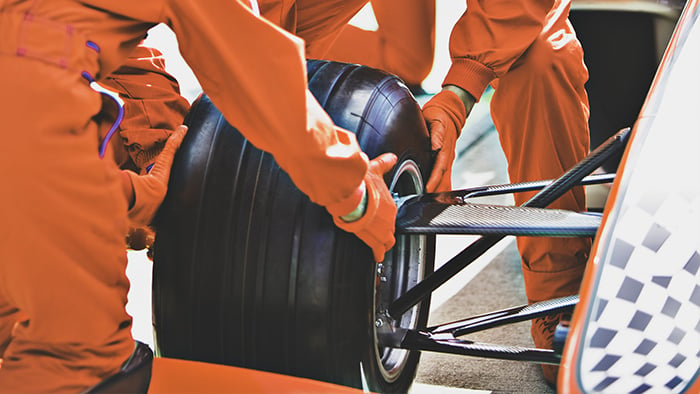- Security
- Privacy
- Performance
Why Your iPhone is Slow and How to Speed it Up
Every new iPhone is faster than the last. But at the same time, iOS and app requirements increase as well. As a result, your iPhone might seem sluggish, especially if it’s a few years old. Ready to give your phone more oomph? This article helps you get your iPhone back to how it felt when it was fresh out of the box.

Written by
Published on September 9, 2019
Sandro Villinger
Published on September 9, 2019
This Article Contains
This Article Contains
Yes, things are slower
No matter which computer, tablet, or phone you use, the more apps you install, the slower the device gets. That’s because many apps, such as Spotify, Skype, or WhatsApp, stay active all the time – even when you’re not even using them! In some cases, it makes sense: if you use an app to give you turn-by-turn directions or to send you an alert, you want it to monitor things in the background so it can tell you, “Turn right in 500 feet,” or “The garage door has been opened.” But not every app needs to run all the time, particularly because doing so consumes processing speed and drains your battery.
Background apps are one of the factors that can make your iPhone run slower. The following steps will help you go through every single one of them to solve your iPhone’s bottlenecks in no time.
Before you start, make sure that the slowdown isn’t caused by something suspicious happening on your phone. To do that, download our free Avast Mobile Security app, which protects you online against unsecured Wi-Fi networks and password theft.
Clean up your phone and remove unused apps
Low storage space can lead to all sorts of issues, including system slowdowns. The first step towards a faster phone is to delete the applications you no longer use. In addition to decluttering the screen (a good reason in itself), removing out-of-date apps gives your mobile device more resources to work with —-- just like cleaning up off your kitchen counter before you begin to cook dinner.
Begin by going through your apps (found under Settings, General, iPhone Storage). Delete the apps you haven’t used in a while, or delete their cache files. We put together some instructions on how to clean up your iPhone and iPad, and how to clear cookies and cache on iPhone devices. 
To take your cleanup a step further, consider using a dedicated tool like Avast Cleanup for iOS to go the extra mile. It helps you quickly free up space on your iPhone by organizing your photo library and removing unnecessary clutter, like duplicate or low-quality images that take up valuable storage.
Bring your iPhone up-to-date
Updating your iOS is actually an important step to ensuring things run smoothly.
One myth about operating system updates is that they make the system slower; some people even think that phone makers do this on purpose to encourage you to buy a new phone! However, the latest iOS releases are actually optimized for performance on older devices, having been trimmed down noticeably. In addition, the updates protect your phone against security vulnerabilities, certainly another performance issue.
To check for updates:
-
Open the Settings app and go to General.

-
Tap on Software Update.


Found an update? Install it!
Don’t stop with iOS. Make sure that your installed apps are up-to-date as well; app makers improve performance or fix bugs on a regular basis, which can have a positive impact on overall performance. To update apps, open the App Store app, navigate to Updates and update everything you find.
By default, iOS automatically updates all your apps, but take a moment to confirm that this feature is enabled. Go to Settings, tap on iTunes & App Stores, and make sure that the Updates setting is switched to On.

Turn off background activity and notifications
The more apps you install, the slower the phone becomes, and the sooner it runs out of battery life. This certainly won’t happen immediately. However, after you install a dozen – or a hundred – apps, you’ll notice a significant slowdown.
The reason is that many mobile apps come with clutter that runs on your phone, even when you’re not using the app. They check for updates and notifications in the background, which you should limit, and they may “phone home” with data that tracks your mobile phone usage.
Make sure that you only keep apps installed when you actually use them. (See “Clean up your phone and remove unused apps” above.) Once you narrow down the selection to the apps you care about, you should limit their background activity. Tell apps such as Spotify, for example, not to download podcasts automatically in the background. And change the Weather app’s settings so that it doesn’t refresh unless it’s open.
This might cause some inconvenience, but it puts you in control. There’s no issue with opening an app and waiting for a second or so for it to refresh, especially when doing so saves battery life and improves your iPhone’s performance.
Turn off background activity
-
Open the Settings app. Go to General and then Background App Refresh.

-
You have two choices. First, you could turn off all background activity — which is easy, but rarely ideal. Alternatively, you can turn off background activity for apps individually. This makes the most sense for apps you rarely use, or apps that don’t need to be refreshed in the background. It has never made sense to me that the Books app runs constantly when not actively in use.
Turn off notifications
I find that only a handful of notifications are actually useful and important. The rest are a distraction and cause both battery and performance drain.
-
To turn off unnecessary notifications, open Settings and go to Notifications.

-
Go through the apps list. For each one, decide whether you want that app to check for and send you notifications.
For example, at around 8pm every evening, I get a notification from eBay showing my status on saved searches. I don’t really need that, so I switch off notifications coming in from eBay.


Turn off the eye-candy
Fancy animations and transition effects are certainly nice to look at, but if you are trying to wring the most performance possible from an older iPhone, the “fun stuff” can be a drain. For a speed boost, here’s how to disable animations and other visual effects:
-
Open the Settings app. Go to General and then Accessibility.

-
Flip the switch next to Reduce Motion. This turns off the animation shown when you go back to the home screen and switch between apps.
-
Next, tap on Reduce Transparency and set that to Off as well. This disables all fancy blurry transparency.
If you can live with the somewhat less-exciting look, you can expect a slightly snappier experience — a boon especially on older phones.
Disable location services
The iPhone’s GPS constantly tracks your current location. useful for apps such as Google Maps, Find My Friends, and Yelp. Turning off GPS location services is more of a battery drain than a performance fix, but doing so does save your phone a few wasteful processing cycles.
-
Open up the Settings app. Navigate to Privacy. Choose Location Services.

-
You can turn off Location services for all apps, if you like, but I do not recommend that unless you never use GPS. Alternatively, turn off location tracking on an individual basis. For example, I turned off location services for all apps except a few select ones like Uber and Google Maps. This alone had a significant impact on my battery life; on average, I got another 1½ hour per day.
Reboot to fix a slow iPhone
Sometimes there’s nothing more refreshing than a reboot. It clears your memory, ends all running applications, and generally improves your iPhone’s performance. Here’s how:
-
If you have an iPhone 8 or newer, press and hold down the Power and the Volume Up buttons.
-
If you’re on an iPhone 5, iPhone 6, or iPhone 7, hold down the Home button and the Power button at the same time for a few seconds.
You can also power your phone down the standard way, then power it back on again. Hold down the Power button, then swipe the slider to the right to turn off your phone. Wait a few seconds until it’s properly shut down, then press the Power button again.
Alternatively, you can turn off your phone under the Settings app. Go to General and scroll all the way to the bottom, then tap Shut Down.
Protect Your Phone from Slowdowns and Malware
Going through regular performance and optimization steps is just one step towards prolonging the lifespan of your device. Now that you’ve boosted its performance, you should take a look at your iPhone’s security and make sure it’s capable of preventing attacks. And yes, even iPhones can be impacted by malicious software, trying to steal your passwords or other data. Avast Mobile Security ensures this won’t happen to you.
Prevent Your iPhone from Slowing Down
Install free Avast Mobile Security for iOS to fight threats and prevent your iPhone from slowing down.
Prevent Your iPhone from Slowing Down
Install free Avast Mobile Security for iOS to fight threats and prevent your iPhone from slowing down.
Prevent Your iPhone from Slowing Down
Install free Avast Mobile Security for iOS to fight threats and prevent your iPhone from slowing down.
Prevent Your iPhone from Slowing Down
Install free Avast Mobile Security for iOS to fight threats and prevent your iPhone from slowing down.
This Article Contains:
More Performance Articles
/Academy-How-to-speed-up-your-browser-Thumb.jpg)
Why Is My Browser So Slow? How to Speed Up Chrome, Firefox, and IE

Mac Running Slow? 15 Proven Solutions to Speed Up Your Mac

Why Is My Phone Internet So Slow? Tips to Make Your Data Faster

Why Is My Internet So Slow & How to Speed It Up

How to Speed Up Your PC

How to Clean Up Your Android Phone

Why Is My Android Phone Slow and How to Speed It Up

Why Your iPhone is Slow and How to Speed it Up
Optimize your Android with free Avast Cleanup
Avast Cleanup
Free installProtect your iPhone from threats with free Avast Mobile Security
Avast
Mobile Security
Speed
Performance
Sandro Villinger
9-09-2019